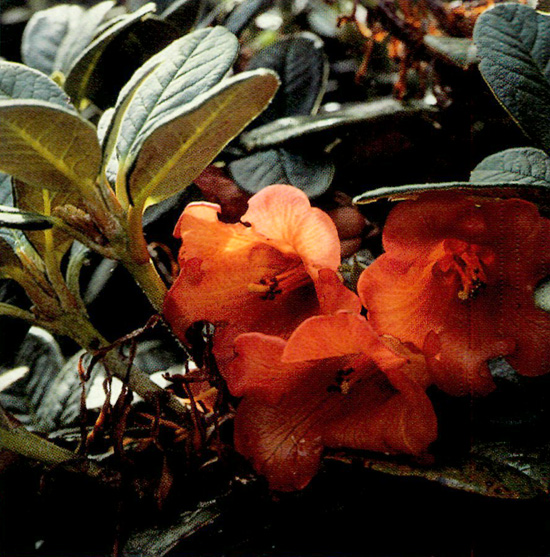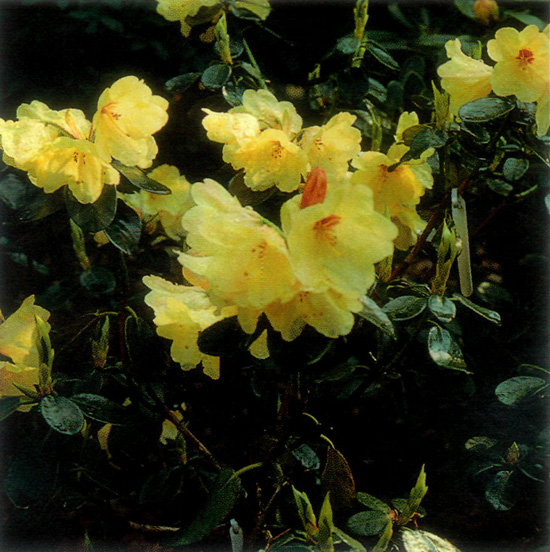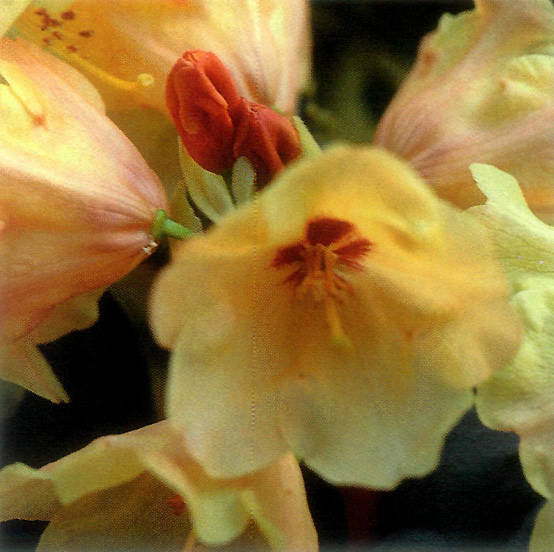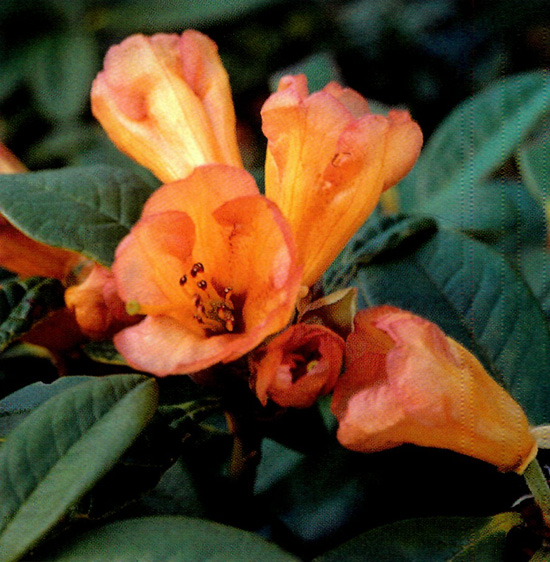JARS v54n3 - Let's Talk Hybridizing: Hybridizing for Orange
Let's Talk Hybridizing: Hybridizing for Orange
Carl Adam Lehmann
Copenhagen, Denmark
What a title! Elusive and desirable. When you go through the ARS Seed Exchange list over the years, this is the trait that most hybridizers are looking for. Of course I had to go the same way, having bought my first rhododendron 'Flava' in 1975 and naturally wanting to do the impossible.
In 1977 when visiting the Botanical Garden in Bremen, Germany, a plant labeled Rhododendron chaetomallum Exbury Orange begged for attention (Figure 3). It had the colour I wanted and, besides, also offered some fabulous dark green foliage. Asking the director for plant material I was treated to all I wanted. However, there was a but - the plant was in bad shape with beginning chlorotic foliage and I was asked if I could bring back a rooted or grafted plant as replacement.
 |
|---|
Figure 3. R. citriniflorum ssp. horaeum. Photo by Carl Adam Lehmann |
With the help of a friend, both versions were reintroduced the next year, and the grafted plant was definitely healthier than the plant on its own roots. For those of you who do not grow Rhododendron citriniflorum ssp. horaeum Forest#21850 (this was the plant's real name) I should send a warning: it is difficult, loses all leaves in the fall when it gets too wet, and requires a cool place in a top draining medium besides. Flowers droop, and it is early in the season but also with some flowers set in September.
 |
 |
|
|---|---|---|
Figure 1. 'Flava' x R. citriniflorum ssp. horaeum. Photo by Carl Adam Lehmann |
Figure 2. 'Flava' x R. citriniflorum ssp. horaeum. Photo by Carl Adam Lehmann |
In 1977 the pollen was applied to 'Flava', a German hybrid between Rhododendron wardii (LS 5679) x R. degronianum ssp. yakushimanum 'Koichiro Wada', and the resulting selected clone is now 1.75m x 1.50m (Figures 1 2), having survived 25 C below freezing. It has a warm tone to the yellow, but is not orange except when the bud is opening. Flowers are somewhat small with the red blotch that comes from the LS #5679 form of R. wardii. I must confess to preferring flowers in harmony with the leaves, and these are a thick leathery polished green that delights all year round. The sap rises early, so bark split can be a problem in areas prone to early spring followed by frost, but hardiness has not been a problem, with a minimum of 25C below freezing recorded.
 |
|---|
Figure 4. R. aureum hybrid. Photo by Carl Adam Lehmann |
Also in 1977, Rhododendron aureum was used as seed bearer, and the resulting plant (Figure 4) is a dwarf, measuring 25 x 40cm today. This hybrid came about as a result of a number of R. aureum crosses that were made in collaboration with Jack Rosenthal of Long Island, New York.
Earlier findings seem to confirm that the two elepidote species that are keeping their progeny small are Rhododendron aureum (as mentioned in the Fall 1999 issue of the ARS Journal under the above heading "Let's Talk Hybridizing") and R. forrestii ssp. forrestii Repens Group with maybe R. proteoides and R. pronum as new candidates. Rhododendron aureum hybrids, however, do not seem to keep their foliage for more than one year, and I wanted better than that.
But how to get on from here? Kenneth N. E. Cox of Glendoick, Scotland, told me that they had indeed used horaeum in hybridizing, but with no results to show for it so far. I know of nobody else using horaeum.
Crossing the two above hybrids was the best I could come up with, and the seedlings look like many seedlings: promising, but too young to show their value and none have flowered so far. They do, however, stay low, but the spread is tremendous, even between the ten plants that I have selected. Time will show if there is a winner.
For the record it should be mentioned that some other crosses have been made using Rhododendron citriniflorum ssp. horaeum pollen. Rhododendron degronianum ssp. yakushimanum x citriniflorum ssp. horaeum is orange all right, but the flowers drop down between the leaves. Foliage is good, but it looks too much like other yak hybrids and gets leggy with age. It may, however, be more tolerant to other climates. R. lanatum x R. citriniflorum ssp. horaeum and R. degronianum ssp. yakushimanum x R. citriniflorum ssp. horaeum F2 still have to flower.
Carl Adam Lehmann is past president of the Danish Chapter.
by Chase Dooley

